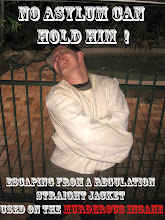During the recent trip to Japan to train with senior members of the Bujinkan, Shirashi Sensei presented Sensei Johnstone with a gift for Jissen Dojos International in the form of a Demon Mask. The Demon Mask is found within the nine ryuha of the Bujinkan, particularly within the Kumogakure Ryu. Demon Masks, however, feature prominently within other aspects of Japanese culture, especially within Noh Theater, Shinto Ritual Dances and Kyogen Plays. There are a large variety of different 'Demon Masks', and they are far from Uniform. Briefly I'd like to explore the Demon Mask and its' relationship to Ninjutsu.
The most commonly known Demon Masks are arguably the Hannya, the Oni and the Tengu. The Hannya is widely know in the West as it is a very common Irezumi (Japanese Tattooing) design. It is usually considered to represent a women whose jealousy or obsession is so extreme that it turns her into a demon.
Tengu (literally 'Heavenly Dogs') are Bird Demons, and the masks that represent them have either a beak, or a very long nose. The Tengu in some Ninja creation myths is said to have taught the original Ninja. We find similar stories of Tengu linked to Yamabushi and other mountain ascetics who practiced Shugendo and were said to develop super-natural powers. These same ascetics are said to have founded Ninjutsu in other creation myths, so there is a common link here. We must consider that having stories of demons or ascetics with super-natural powers as teachers, infers that the Ninja themselves had such powers. In feudal Japan this is both a good cover story to conceal the real origins/ techniques of Ninjutsu; and a powerful form of psychological warfare against superstitious minds.
Oni are gigantic demons which are somewhat humanoid, but have characteristics of both Oxen (Horns) and Tigers (Claws, Fangs and often a tiger fur loincloth). There skin is often blue or red, and they are very strong. Often they are armed with an iron club. Originally they were more spiritual beings who caused disease, disaster and warfare, a characteristic they share with the Tengu. Also like the Tengu, Oni have over time come to be a symbol of protection against evil, rather than being evil. At first this seems strange, but if we consider that sometimes you need a mean individual to scare away other mean individuals, it makes more sense. This is along the lines of "he's a bad guy", "yeah but he's OUR bad guy". Better the devil you know.
We find a link between Ninjutsu and Oni within the esoteric aspects of the art, particularly Kuji Kiri (the 'nine cuts'). This is a practice of cutting horizontal and vertical lines, using the 'sword fingers' mudra, over the symbol for Oni as a kind of protective spell. This is by no means something unique to Ninjutsu, rather it was taken from Buddhism and Daoism (also spelled Taoism). Kuji kiri and Kuji-In (the famous finger knitting practice made famous by Stephen Hayes & 80's ninja movies) are in-depth subjects which are beyond the scope of this article, so I will give only a brief overview. The first written reference to the Kuji Kiri is by the Chinese Daoist Master Ge Hong (283 - 343) in the Neipian. He uses says it is a a spell for safety in the mountains, which were thought to contain many dangerous entities in Chinese folklore. So we can see why this would be considered to be a useful charm be the Ninja families, who lived in the mountainous regions of Koga and Iga.
If we examine other later Daoist ritual texts we will find the the Kuji Kiri is to be performed in the north-eastern direction. This direction is called the Demon Gate ('Kimon' in Japanese) and is one of two directions from which evil is considered to enter the world. By cutting the lines of the kuji-kiri we symbolically seal out evil influences and provide protection. When we look at the Chinese astrology we find that the North Eastern direction is the 'Tiger-Ox' direction and now the Oni's appearance starts to make sense.
Another fact not found in any published Ninjutsu text, new or old, that I'm aware of, is that the Kuji Kiri is sometimes cut with four horizontal and five vertical lines, but at other times it is the opposite. This fact can be found in the Chinese Daoist ritual texts, and is dependant on the day on which the Kuji Kiri is performed. This relates to some of the material found within the Tenmon ('Heavens Gate' - Astrology, Astronomy and Meteorology) aspects of Ninjutsu.
Back to Shirashi Sensei's gift to the dojo, I believe he has given us this gift to bring good luck and ward away evil from our dojo. Shirashi Sensei, thank you for this wonderful gift, we are deeply honored.
Jun 14, 2011
Subscribe to:
Post Comments (Atom)

No comments:
Post a Comment